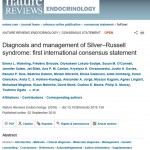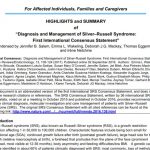
What is SRS?
Silver Russell Syndrome [SRS], or Russell Silver Syndrome [RSS/SRS] is a rare disorder characterized by intrauterine growth retardation and postnatal growth deficiency along with a handful of common physical characteristics and a range of other symptoms. The incidence is unknown but is estimated at 1 per every 30,000 to 100,000 live births. The wide spectrum of phenotype findings vary both in incidence rate and severity from one individual to another. Besides prenatal and postnatal growth retardation, the most common characteristics are normal head circumference (appearing large for the body) at BIRTH , a large forehead that protrudes out from the plane of the face, a triangular-shaped face, a pinky that is shaped in a curved position (clinodactyly), lack of appetite/low BMI, and undergrowth of one side or limb(s) of the body (hemihypotrophy), resulting in unequal (asymmetric) growth. The majority of children with RSS/SRS fall within the normal range of intelligence, but are more likely to have motor and speech delays; this can vary by the child’s genetic cause. Intervention at an early age (infancy) is critical. RSS/SRS is genetically heterogeneous, meaning that different genetic abnormalities are believed to cause the disorder. Abnormalities affecting certain genes on chromosomes 7 or 11 have been found in up to 60-70% of RSS/SRS patients, leaving approximately 30-40% of patients where the underlying cause of RSS/SRS is not known and the patient must be clinically diagnosed.





